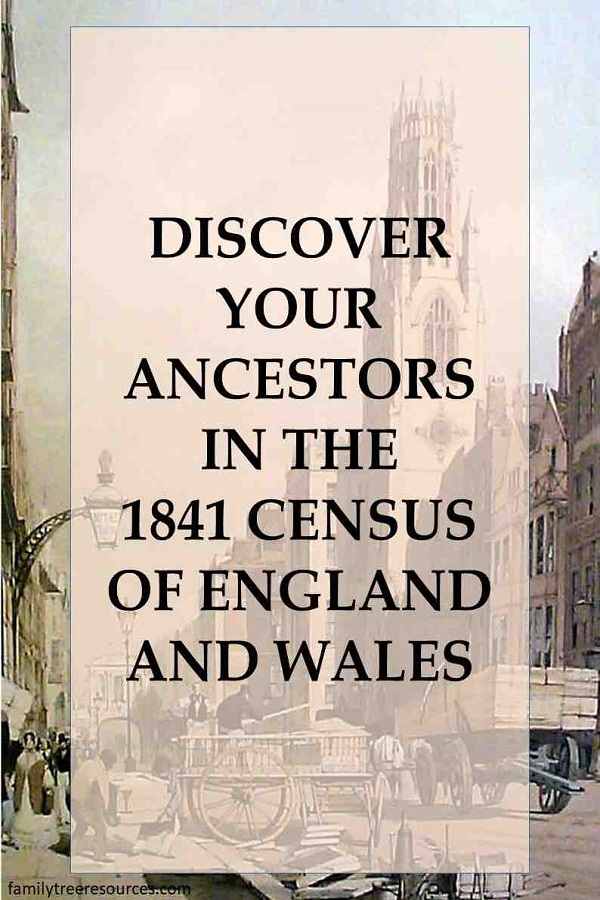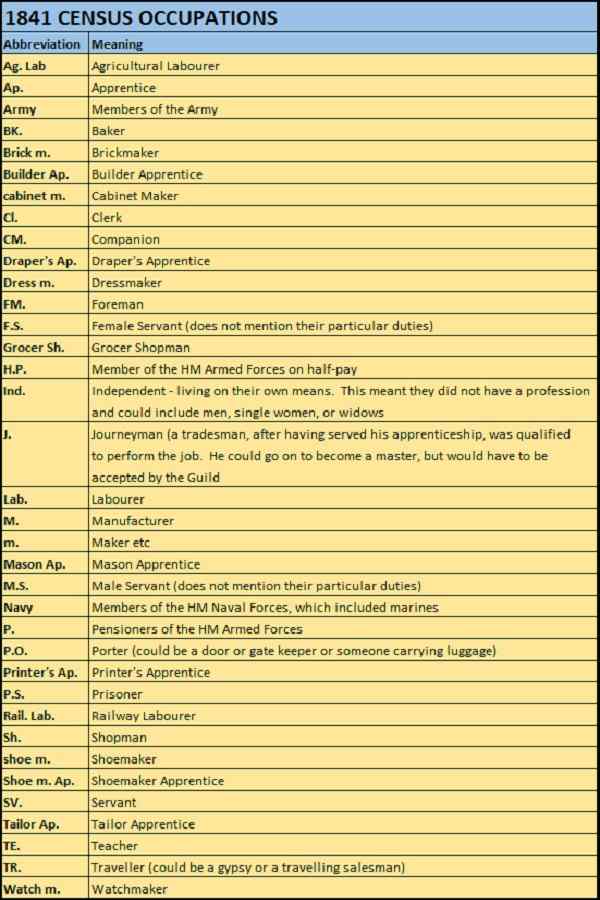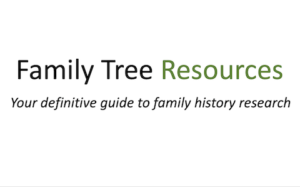
The 1841 Census of England and Wales, taken on 6 June 1841, was the first census taken at the same time across the country.
The census occurred because the Population Act 1840 was enacted, in which a position was created which was entitled ‘Commissioners for taking account of the population’.
Earlier censuses were administered by Overseers of the Poor.
The Registrar General and the Superintendent Registrars, who maintained responsibility for registrations of births, marriages and deaths, were made responsible for the administration of the 1841 Census.
One enumerator was appointed per census district, approximately 35000 in all, and they were responsible for collecting details from a population of around 16 million.
Civil Registration and the taking of the Census became inter-connected for the first time, so any change in the local boundaries or districts affected them both.
How Was The 1841 Census Taken?
Enumeration Districts were made up of subdivisions of Civil Registration Districts, and were designed so one person could, in a single day, collect data from all households in the area. There were around 200 households in each enumeration district.
A pre-printed census schedule was delivered to every household a few days before the census was due to be taken. The householder was required to state the names, ages, sexes, occupations and birth places of every person who lived at the address. This schedule was then collected by the enumerator.
If the householder was illiterate, or could not complete the schedule for another reason, the enumerator would help them.
It was not uncommon, however, for the enumerator to mishear what was said by the householder, especially if he had a strong accent, so the enumerator may have transcribed the information provided incorrectly.
It is best, in these circumstances, to double check the information provided on the census with other sources, such as parish registers or, if the person was still living, the 1851 Census.
On each page, the enumerator would total up the number of males and females in the columns, and the number of inhabited and uninhabited houses.
The enumerator copied the census schedules into official books, with the original schedules being destroyed. When you peruse the 1841 Census, you look at the census enumerator’s books.
You should consider that the enumerator could have made a mistake when he was transcribing the information from the schedules into the books.
A / marked the end of a household, but // marked the end of a building. It is important to remember that many households may be located in one building.
What Can the 1841 Census Tell You?
The census can tell you where your ancestors were living on census night. You can also determine their age, who else lived in the house, their occupation, and if they had servants. Looking at other houses in the same area can also tell you the family’s social circumstances.
Refusal to Answer Census Questions led to Fine
It was considered an offence to refuse to answer a question on the census or to provide information that was knowingly inaccurate. If anyone was found guilty of such an offence, they were fined.
Relationship to Head of Household Not Stated in 1841 Census
Occupants’ relationship to the head of the household was not recorded. If a lodger was living with the family on census night, he/she was not recorded as such.
Different Ways Enumerators Recorded Information in Census
Enumerators collected the information from householders in many different ways. Some enumerators listed the surname followed by the first name, whilst others listed the first name first, followed by the surname.
Some enumerators did not always write down the last name in every instance. If people living in the house had the same surname, the enumerator wrote do, short for ditto, meaning ‘as above’.
Some enumerators abbreviated the marital status of the householder, such as M for married, U or Un for unmarried and W for widow or widower.
What is a Census Reference?
The census reference is still useful to know even if you are perusing the census online. These references do not change even if different websites have different ways of operating their search facilities.
A census reference can be useful if you can find your ancestor on one site but not on another because the transcription of the index is different.
If you know the full census reference, you can find an exact census page, which is useful if you are not able to find your ancestor using a website’s search facility. Online street indexes are also accessible.
The census reference for the 1841 Census begins with HO 107, which is the department code (letter) followed by the series number.
This is then followed by the piece number. For example, Leeds Registration District covers 1343-1349. These pieces are then divided into books, so the full reference would also include this number. For example, the full reference for Belgrave Street would be HO 107/1349/1.
This reference would then be followed by the folios for the house numbers in the street, for example, Belgrave Street is on folios 21-23, 32 and 39-40. You would need to peruse all these folios to see the full number of houses on this street.
1841 Census Addresses
Only a very brief description of the address was entered in the Census, but all household occupants were recorded for the first time. The address was rarely written at all in villages because it was not considered to be necessary.
You can search the 1841 census street index, but it is necessary to know the address your ancestor was living at. This is only available for towns and cities, villages are not included.
1841 Census Ages Rounded Up or Down
In the 1841 Census, the ages of occupants over the age of 15 were rounded down to the nearest 5 years. For example, someone aged 53 would be transcribed as being 50, and a person aged 22 would be listed as being 20.
When looking for your ancestor’s baptism in parish registers, which would be the only option open to you because civil registration did not begin in England and Wales until the September quarter of 1837(includes July, August, and September), it is prudent to check for 3 or 4 years either side of the year in which you believe they were born.
Sometimes the enumerator recorded exact ages, which is a great help to the family historian because it makes it easier to trace their baptism.
Many people did not know how old they were, so guessed at their age, which is a reason why their age varies from census to census.
Instructions Given to 1841 Census Enumerators
Other instructions were also given to the census enumerators.
1841 Census Occupations Abbreviations
Occupations were noted for the first time, with the enumerator using occupation codes including:
| 1841 Census Occupations Abbreviations | |
|---|---|
| Ag. Lab. | Agricultural Labourer |
| Ap. | Apprentice |
| Army | Members of the Army |
| BK. | Baker |
| Brick m. | Brickmaker |
| Builder Ap. | Builder Apprentice |
| Cabinet m | Cabinet Maker |
| Cl. | Clerk |
| CM. | Companion |
| Draper’s Ap. | Draper’s Apprentice |
| Dress m. | Dressmaker |
| FM. | Foreman |
| F.S. | Female Servant (does not mention their particular duties) |
| Grocer Sh. | Grocer Shopman |
| H.P. | Member of HM Armed Forces on half-pay |
| Ind. | Independent – living on their own means. This meant they did not have a profession and could include men, single women, or widows |
| J. | Journeyman (a tradesman, after having served his apprenticeship, was qualified to perform the job. He could go on to become a master, but would have to be accepted by the Guild |
| Lab. | Labourer |
| M. | Manufacturer |
| m. | Maker etc. |
| Mason Ap. | Mason Apprentice |
| M.S. | Male Servant (does not mention their particular duties) |
| Navy | Members of the HM Naval Forces, which included marines |
| P. | Pensioners of the HM Armed Forces |
| P.O. | Porter (could be a door or gate keeper or someone carrying luggage) |
| Printer’s Ap. | Printer’s Apprentice |
| P.S. | Prisoner |
| Rail Lab. | Railway Labourer |
| Sh. | Shopman |
| shoe m. | Shoemaker |
| Shoe m. Ap. | Shoemaker Apprentice |
| SV. | Servant |
| Tailor Ap. | Tailor Apprentice |
| TE. | Teacher |
| TR. | Traveller (could be a gypsy or a travelling salesman) |
| Watch m. | Watchmaker |
I have also created a jpg chart:

Birth Place Not Recorded in Detail in the 1841 Census
The 1841 Census did not give details of a person’s birth place, instead stating whether or not they were born in the county in which they were living. If not, it was marked ‘N’ for not in the county but elsewhere in England, ‘S’ for Scotland, ‘I’ for Ireland or ‘F’ for Foreign Parts.
If a household member did not know where they were born, NK was written. This stood for ‘not known’, which is always disappointing when conducting family tree research because it makes it much more difficult to ascertain their place of origin.
1841 Census Missing Pieces
It is also important to note that some parts of the return have missing pieces, as parts have been lost over the years, so if you are unable to find your ancestor on the census, please bear this in mind. Counties in which some parishes are missing from the census include:
- Cheshire
- Derbyshire
- Hampshire
- Kent
- Middlesex
- Northamptonshire
- Oxfordshire
- Somerset
- Surrey
- Wiltshire
- Yorkshire
Problems With the 1841 Census
One of the major problems with the Census is that because it was written in pencil, some pages have badly faded over the years, and are now unfortunately illegible on the microfilm copies of the census.
It can be very difficult to read the handwriting on the Census Returns.
Another problem was that because the return was compiled on 6 June, which was a harvest night, some agricultural labourers may have been missing from the census because they were working. They may have slept outside or were away from the family home.
1841 Census Headings
- Place
- Number of uninhabited and inhabited houses
- Names
- Age and Sex (different columns for males and females)
- Profession, Trade, Employment, or of Independent Means: Occupation
Where can I find the 1841 Census?
Most County Record Offices hold the 1841 Census for their local area. These can also be viewed at the National Archives.
The National Library of Wales holds the 1841 Census on microfiche for all of Wales.
It is also possible to access free census records on-line at freecen which is transcribed by volunteers and contains partially complete indexes, although more information is being added all the time.
Ancestry
Ancestry is great for anyone who does not have the time to, or is unable to, visit Record Offices or Libraries.
It is especially good if you wish to access records from the comfort of your home.
Read my in-depth review to find out more about its features, advantages, and disadvantages.
FindmyPast
FindmyPast is good for anyone, whether they are just starting their family history journey, or have already conducted some research.
It is especially good for people who wish to read newspaper articles.
Read my in-depth review to find out more about its features, advantages and disadvantages.
